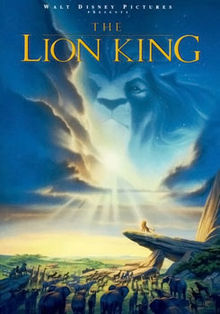Disney’s
“The Lion King” (1994), directed by Roger Allers and Rob Minkoff, is two spots
ahead of “Aladdin” on Empire Magazine greatest movies list. It makes sense since
it has once again all the elements
of the classic Disney animated movies: great hand-drawn animation, themes of good
versus evil, comedy sidekicks, cute animals, musical numbers and father issues.
The story line in “The Lion King” actually tries to be a bit deeper by
borrowing elements from “Hamlet.” If you are going to have a Shakespearean
villain, you might as well have him voiced by Jeremy Irons.
Since
Disney has always been keen to market its product on every platform as soon as
possible, the first I saw of this movie was in an illustrated book before the
movie itself even came out. Then after watching the actual movie of course my
brother and I ended up renting the game for Super Nintendo and my parents
bought the soundtrack on audio cassette. These marketing guys really know their
thing. Since I was the age of the target audience at the time it came out, I
can’t deny they were marketing a good product. My family and I saw the movie in
theatres in Québec and liked enough to ask for the VHS tape to watch on a loop
once we moved to Chile. Throughout our many moves in the 90s, we ended up hauling
a lot of videotapes.
The
lion has been described as the king of the savannah and in a Disney movie they
take that literally. King Mufasa (James Earl Jones) rules over the Pride Lands
of Africa. When his son Simba (Jonathan Taylor Thomas) is born he is heralded
as the future king of the land, much to the dismay of his uncle Scar (Jeremy
Irons), who has his eyes on the throne. While Mufasa is busy teaching his son
the responsibilities of being a king and his whole circle of life philosophy,
Scar is planning a coup.
Luring
Simba in a gorge, he orders hyenas Shenzi (Whoopi Goldberg), Banzai (Cheech
Marin) and Ed (Jim Cummings) to cause a stampede of wildebeest. Mufasa rescues
Simba, but dies in the gorge with a little help from Scar. After Scar convinces
Simba his father died because of him, Simba flees the land with the hyenas on
his tail. They abandon pursuit figuring he will die all alone in the savannah.
That’s the problem with henchmen in movies: they never get the job done.
Simba
does manage to survive thanks to two of Disney’s funniest comedy relief
characters: meerkat Timon (Nathan Lane) and warthog Pumbaa (Ernie Sabella) who
rescue him from vultures. Seeing the advantage of befriending a lion, they take
him home to their jungle to live under their own philosophy: Hakuna Matata, or
“no worries.” So instead of growing up king of the jungle, Simba grows up with
the equivalent of two hippies eating bugs and kicking back in the woods without
a care in the world. Everything changes years later when the grown up Simba
(Matthew Broderick) finds his childhood friend Nala (Moira Kelly) who tells him
Scar has destroyed the kingdom by letting the hyenas run rampant. A vision of
his father in the sky also reminds Simba of his rightful place in the land, so
it’s time to go home and face the past.
The
animation stands up even by today’s standards, the story is engaging throughout
and Elton John wrote and performed some of the movie’s most memorable songs. As
a child I enjoyed every minute and I imagine the adult audience did too as the
humour works for all ages. Pumbaa even has a joke I did not understand until I
saw Sydney Poitier in “In the Heat of the Night”: “The call me MR. PIG!”
Sadly
there are also a number of controversies attached to the film, from the
allegation the word “SEX” is at one point spelled out in the sky, to racial
undertones because the hyenas are voiced by African-American and Latino actors
who ruin the place once they are allowed in the kingdom. Talk about tainting a
childhood memory. Can’t movies just be movies without all this politically
correct bickering?
Whether
or not there is any merit to the allegations, “The Lion King” is another Disney
success story, spawning sequels, a Broadway play and even a TV spinoff for
Timon and Pumbaa. Good for them, it’s nice to recognize the sidekicks. Just don’t
call one of them a pig.

Comments
Post a Comment